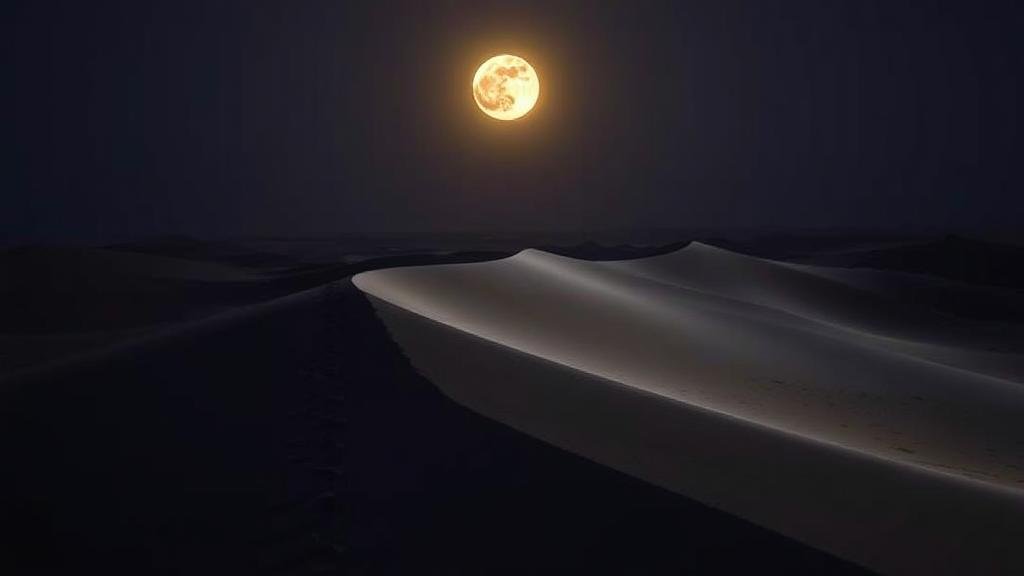Exploring the “Moonlit Sands,” a desert in the Middle East where dunes glow silver under a full moon.
Exploring the Moonlit Sands: A Desert Oasis of Silver Hues
The Moonlit Sands, located in the vast Arabian Desert of the Middle East, is a mesmerizing landscape that captures the imagination of adventurers and nature enthusiasts alike. Under the enchanting light of a full moon, the sand dunes transform into shimmering waves of silver, creating an ethereal experience. This article delves into the geography, unique features, history, and cultural significance of this extraordinary desert environment.
The Enigmatic Geography of the Moonlit Sands
The Moonlit Sands are situated primarily in Saudi Arabia, spanning regions of both the Rub al Khali (the Empty Quarter) and the Al Nafud Desert. e areas are defined by their towering sand dunes, which can reach heights of up to 250 meters (820 feet) and stretches of about 1,000 kilometers (620 miles).
During the day, the dunes appear as a stark contrast of deep ochre and light tan. But, come nighttime, especially during a full moon, the interplay of light and shadow creates a spectacular visual effect. The particles of crystalline silica within the sand create a reflective quality, causing the dunes to appear almost luminescent.
Unique Phenomena: Why Do the Dunes Glow?
The glowing effect observed at the Moonlit Sands is a result of several factors:
- Silicon Content: The sand is primarily composed of quartz, which has high silicon dioxide content. This composition enhances its reflectivity under moonlight.
- Moon Phases: The phenomenon is most pronounced during a full moon when the brightness is at its peak, illuminating the landscape.
- Humidity and Temperature: Higher humidity levels can also amplify the reflective quality of the sand at night, contributing to the dunes silvery gleam.
A Historical Overview
The Moonlit Sands have been a focal point for various nomadic tribes and explorers throughout history. The Bedouins, who have roamed these deserts for centuries, have rich cultural traditions associated with the sand, utilizing it for navigation and storytelling. Historically, this region served as a trade route connecting ancient civilizations in the Arabian Peninsula.
In the early 20th century, the Moonlit Sands attracted Western explorers like Wilfred Thesiger, who documented his travels and experiences in a way that highlighted not only the physical landscape but also the intricate connection between the land and its inhabitants.
Ecological Importance
Despite its arid nature, the Moonlit Sands support a diverse range of flora and fauna adapted to survive in extreme conditions. Species such as:
- Sand Gazelles: Known for their ability to travel long distances in search of food.
- Arabian Oryx: A species that has successfully been reintroduced into the wild.
- Cacti and Succulents: Plants that have evolved features to conserve water, making them critical to the desert ecosystem.
Research indicates that these ecosystems play a vital role in carbon storage and soil preservation, highlighting the environmental significance of such deserts in the face of climate change.
Cultural Significance and Tourism
The breathtaking beauty of the Moonlit Sands has led to an increase in eco-tourism as travelers seek authentic experiences in the desert. Activities such as:
- Sandboarding: A thrilling way to explore the dunes.
- Stargazing: The clear nights offer unparalleled views of constellations.
- Bedouin Cultural Experiences: Tourists can engage with local tribes, learning traditional storytelling and music.
With responsible tourism initiatives, efforts made to ensure that visitors respect the delicate desert environment while enjoying its unique offerings.
Actionable Takeaways for Adventurers
If youre considering a journey to the Moonlit Sands, here are some tips to ensure a memorable experience:
- Plan Your Visit: Aim for a trip during the full moon for the optimal glowing effect.
- Be Prepared: Pack sufficient water, sun protection, and appropriate clothing for temperature variation.
- Sustainable Practices: Follow Leave No Trace principles to protect this delicate ecosystem.
The Moonlit Sands offer an enchanting experience that goes beyond visual splendor; they are a testament to the beauty and resilience of nature and culture in one of the world’s most arid environments. Whether you are an explorer, a photographer, or simply an admirer of nature’s wonders, this desert will leave an indelible mark on your memory.



